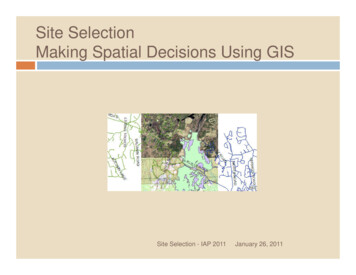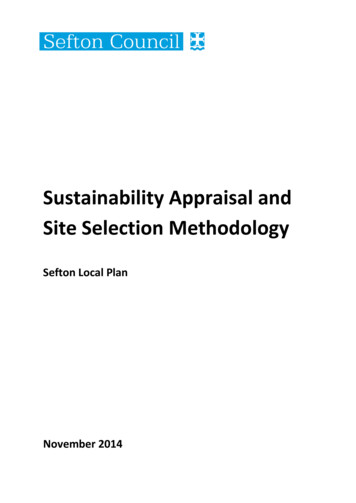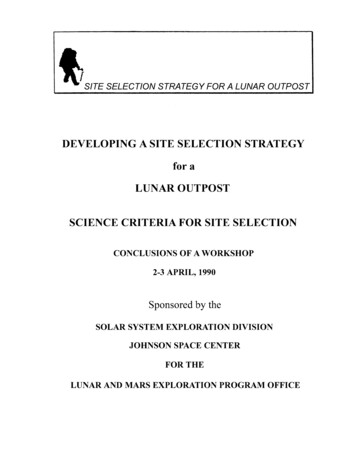
Transcription
Site Selection Criteria in Community Shopping Centers: Implicationsfor Real Estate DevelopersbyBenjamin T. BrubakerBachelor of Arts FrenchBrigham Young University, 2001Submitted to the Department of Architecture in Partial Fulfillment of theRequirements for the DegreeofMASTER OF SCIENCE IN REAL ESTATE DEVELOPMENTat theMASSACHUSETTS INSTITUTE OF TECHNOLOGYSeptember 2004 2004 Benjamin T. Brubaker. All rights reserved.The author hereby grants to MIT permission to reproduce and to distribute publicly paperand electronic copies of this thesis document in whole or in part.Signature of Author:Benjamin T. BrubakerDepartment of ArchitectureAugust 6, 2004Certified by:Brian A. CiochettiProfessor of the Practice of Real EstateThesis AdvisorAccepted by:David GeltnerChairman, Interdepartmental Degree Program inReal Estate Development
Site Selection Criteria in Community Shopping Centers:Implications for Real Estate DevelopersbyBenjamin T. BrubakerSubmitted to the Department of Architecture on August 6, 2004in Partial Fulfillment of the Requirements for the DegreeofMASTER OF SCIENCE IN REAL ESTATE DEVELOPMENTat theMASSACHUSETTS INSTITUTE OF TECHNOLOGYABSTRACTThe purpose of this paper is to investigate retail site selection criteria in communitycenters and ascertain the implications of these criteria for the retail real estate developer.Historically, real estate developers contemplating the development of a community centerwill acquire a site based on hunches, experience, and a limited amount of data. Realestate academics, on the other hand, have produced numerous mathematical models andmethods for retail site selection. However, to the real estate developer the retailcommunity shopping center has remained elusive. Not only will developers oftentimesface the prospect of site selection without a complete picture of who their tenants will be,but they will be left to their own experience to understand in depth the needs andpreferences of typical community center tenants.This paper will explore current methods and site selection criteria used by leadingcommunity center tenants for site selection and will investigate how that information canbe implemented by the developer to improve the ir approach to retail site selection.Thesis Supervisor:Title:Brian A. CiochettiProfessor of the Practice of Real Estate2
Acknowledgements:I express my heartfelt gratitude to the following individuals:To Jay Timon, CRE Class of 1998 for his inspiring attitude of giving back, for all histime, his unexpectedly generous level of academic and financial support he providedduring the thesis process, and for making the thesis process much more of a learning,eye-opening, and fun experience than I thought was possible.To all the retailers, developers, brokers and planners who gene rous ly spent time speakingwith me and made this study possible.To Tony Ciochetti for his insight and time.And especially to my wife for her patience, loving support and encouragement.3
TABLE OF CONTENTSCHAPTER 1: INTRODUCTION .5CHAPTER 2: COMMUNITY CENTERS DEFINED .9CHAPTER 3: EVOLUTION OF MODELS USED IN RETAIL SITE SELECTION.16ADVANTAGES AND DISADVANTAGES OF USING SPATIAL INTERACTION MODELS. 20OTHER METHODS USED IN RETAIL S ITE S ELECTION. 23Regression Models.24Enhanced Analog Models.25CHAPTER 4: NEED FOR MORE INFORMATION .26CHAPTER 5: METHODOLO GY .29CHAPTER 6: FINDINGS .31USE OF MATHEMATICAL MODELS . 31SITE AND LOCATION CRITERIA. 33Visibility.33Access.36Traffic.38Site Size and Character.39Parking.40Co-Tenancy.41D EMOGRAPHICS. 43Income .44Education.45COMPETITION. 45Consumer Search Behavior.46New Markets .46TRADE AREA D EFINITION. 50COMMUNITY C ENTER TENANT CATEGORIZATION AND COMPARISON. 52CHAPTER 7: CONCLUSION.55REFERENCES .57APPENDIX A .59APPENDIX B .614
CHAPTER 1: INTRODUCTIONReal estate developers make few decisions that are as crucial as selecting the site of theirnext development. This decision will affect which tenants will be interested in locatingin the center, which consumers will frequent the center, and the sales volumes of all thetenants who choose to locate in the center. In short, the decision will largely determinethe success or failure of the project and will determine whether the developer andinvestors in the project will in fact realize negative, average or superior returns on theirinvestment of capital and time.In past periods of time, retail site selection was relatively straight- forward. Retail nodescoincided with major city centers and any other lesser concentrations of retail weresimply representative of smaller outlying localities. But today we find ourselves in amuch more complex period of time with respect to successful development and locationof retail deve lopment. Retail agglomerations today are located away from city centersand sometimes in sparsely populated locations. Recent economic changes have beenaccompanied by rapidly evolving retail trends which are difficult to predict, makingestimating the success of a new retail outlet equally as challenging.In response to the increasing complexity of modern retail site selection, academics andentrepreneurs, since the early 1930’s, have been inventing and reinventing complexmodels to better predict and measure the propensity of any retail site to succeed. From5
the early gravity model Reilly revealed in 1929 1 to the location allocation and spatialinteraction models of today, these methods allow the mathematical delineation of tradeareas and forecasting of sales volumes to some degree of accuracy. This being the case,the retailer today that uses these models will still combine the ir results with the subjectivejudgments and managerial experience which continue to be extremely important to thesite selection process. On paper, land and space can be treated as relativelyhomogeneous; however in reality every site must be considered and analyzedindividually. Even something such as poor access or the inability of the site plan toaccommodate the necessary parking requirements can singularly cause the failure of ashopping center investment. The subjective component of retail site selection mustcertainly be taken into account as time-proven experience as a “gut feeling” will also playa part in the site selection process.Community shopping center developers however have been said to be the true “artists” ofsite selection. Without retail sales data that typical mid size category killer tenants useduring their site selection process, and armed usually only with publicly availabledemographic and competitive information, they are left to sift through the available datawith much discretion to use whatever methodology they choose to try to envision andfind the best site for their community center development.Improvements in technology and computers are giving developers more options to theirsite selection approach. GIS and mapping software is becoming easy to use and much1Reilly, “Methods for the Study of Retail Relationships” p. 166
more affordable than in the past. Software that once required a professional installationand tens of thousands of dollars can now be purchased for a couple hundred dollars andset up on a computer in minutes. In addition, advances in technology and the internet aremaking it extremely easy to locate information on retailer outlet locations, competitiveshopping centers etc.Despite all these new tools, it is important that developers remember that they “shouldnot attempt to replace their instinctive reaction to a property with research. But they canno longer afford to depend solely upon that instinct. Effective site selection is neither ascience not an art: It’s a transcendental marriage of the factual parameters and intuitivepassion that define the two disciplines.”2With this in mind this study will explore the methods and mathematical models that havebeen derived by scholars and entrepreneurs in the past. This paper will then attempt totake the process one step further by conducting direct interviews with retailers, and otherreal estate professionals. This will be done in an effort to ascertain what it is thatcommunity shopping center tenants want today, and how they arrive at the conclusionthat a particular location and site is in fact desirable. This study will also determinewhether spatial interaction models and other methods are applied in practice bycommunity center retailers.2Hawkins, “Quantifying the Art of Retail Site Selection” p. 877
With a better understanding of what retailers want, and what goes into their predictionthat a new location will be profitable, community shopping center developers will be ableto add to their knowledge base and better understand how to seek out a new communityshopping center site which will be attractive to tenants and ultimately the consumers.8
CHAPTER 2: COMMUNITY CENTERS DEFINEDA community center has been defined by the Urban Land Institute as follows: “acommunity shopping center usually has a junior department store or a discount store asthe major tenant. The community shopping center is typically about 150,000 square feetof store area but ranges from 100,000 square feet to 450,000 square feet.” Thecommunity shopping center, in terms of size and consumer draw, falls betweenneighborhood and regional shopping center. A typical community shopping centerrequires a minimum site area of 10 to 40 acres, serves a trade area of 40,000 to 250,000people within a 10 to 40 mile radius depending on the density of the surrounding area.Over the last few decades the community center has evolved from the store of thirty yearsago that was usually anchored by a supermarket and a junior department store, to thelarger community center of today with a “big-box” anchor tenant which is likely to be anlarge- format off-price discounter, a home improvement store, a furniture warehouse orsome other specialty store that provides a strong consumer draw. (This anchor may be ona separately owned parcel adjacent to, rather than within the actual development site planas developers may capitalize on vacant land surrounding these tenants.)The community center of today often contains four or more “category killer” mid-sizeanchor tenants which add to the draw of the center and encourage cross shoppingbetween stores. These types of community centers, described in more detail below, will9
often have a trade area 3 that draws from far beyond that of a traditional communitycenter, will sell an extremely wide range of shopping goods and will often appeal to arange of income levels wider than was the case for older community centers. Communitycenter tenants can be divided into roughly four categories:First, the “big box” anchor tenants previously mentioned which occupy more than100,000 square feet of space can be grouped together. These tenants will typically eitherself-develop on land that they themselves have purchased, or in rare occasions whereother sites are not available, they will build on land that had been leased from thedeveloper. Examples of these types of tenants are Costco, Home Depot, Kohl’s, Lowe’s,Sam’s, Target, and of course Wal-Mart.Secondly, mid sized “category killer” tenants will often be found in community centers.The space that these tenants prefer to occupy is in the range of 15,000 to 45,000 squarefeet. These tenants will occasionally self-develop when locating in a stand-alonesituation, or in other words where they are not integrated into a community center but arein a single building on a single parcel of land. Especially in recent years these tenantshave a strong preference to locating within a community shopping center. In thissituation they will not own their space but will rather lease the space from the owner ofthe center. Tenants such as Barnes and Noble, Bed Bath and Beyond, Best Buy,Michaels Arts and Crafts, and Old Navy are examples of the types of retailers which fallinto this category.3Trade Area is defined as the area from which a strong majority of consumers originate.10
A third category of retail tenants in community centers are “mini-anchors” which occupystore sizes of 8,000 to 15,000 square feet. These tenants will not locate in stand-alonesituations and will nearly always lease the space they occupy. Payless Shoe Stores, Petcoand Pier 1 Imports are representative of this category.Lastly, a community center will usually have a number of small tenants which will locatewithin the center. These tenants will occupy less than 8,000 square feet of retail spaceand will usually consist of small shops such as small food service, local boutiques, orwireless phone sales stores.New community centers continued to experienced great success through the 1990s andthe trend has continued through the first part of this decade. With changing consumerpurchasing habits, continued consolidation of retailers, and the difficulty that retailers areexperiencing in finding the adequate space required for their category killer concepts, themodern community center has emerged as the answer to all of these trends.Modern community shopping centers are designed to communicate its particular purposeand distinguish it from its competitors. Some community center developers will even goso far as to design the tenant mix to target a narrowly defined demographic or even agender of consumer. Community centers which target consumers in higher householdincome brackets will often be designed to have the high-end finishes which will seek to11
communicate the quality that these consumers will seek out. Discount-orientedcommunity centers will feature many opportunities to cross-shop and compare betweensimilar retail stores. A female-oriented center will include additional safety and securityfeatures, and female-only concepts such as maternity and women’s fashion. The figurebelow describes two examples of a tenant list for community centers.Table 1: Examples of Tenant Mix within Community CentersCarson Valley Plaza: Carson City, NVHartford Ave Center: Bellingham, MAMajor Tenants:Bed Bath and BeyondBest BuyBordersCostPlus World MarketMarshallsOld NavyPetscoPier 1 Imports702 Scate & BoardAmerica’s Mattress StoreThe Crystal KaleidoscopeCurves for WomenFamous FootwearGamestopGizmo WirelessHollywood Beauty CenterOreck Floor CareSportsclipsMajor Tenants:Barnes and NobleThe Gap/Gap Kids/Baby GapLinens N’ ThingsPayless ShoesRegal CinemaWhole FoodsChili’sFoot LockerHallmark Cards and GiftsHome Mortgage CompanyLearning ExpressRadio ShackWireless Phone StoreCommunity centers today will certainly seek to communicate the convenience thattoday’s consumers are seeking. As the American economy has experienced a recentrecession and begun to embrace a steady recovery, the shopping habits of consumershave changed, with shoppers making fewer trips, purchasing more per trip, and seeking to12
minimize search costs inherent in the shopping experience. 4 In response, communitycenters have become larger over time, have become more strategic in tenant co- location,and focused site specific characteristics such as signage and access to ensure a high levelof convenience to the consumers. Additionally, it is not uncommon for communitycenters to target an increasingly segmented demographic; a practice which is becoming aprimary characteristic of the modern community center. 5Because the community shopping center is an “in-between” center, with its size falling inbetween the regional center and the neighborhood center, it is difficult to categorize interms of its market size and drawing power. The community center is often a centerwhich will adapt to the consumers of the surrounding trade area, as well as adapt in sizeand tenant- mix to the corresponding size of the under-served market it targets. Becausethe community shopping center offer a wide array of shopping goods, and oftenspecialized categories of goods, the market area is often less predictable. In the case ofcommunity centers featuring several mid to large size category killer tenants, the drawmay be nearly as large as a regional center.While community centers feature a wide range of tenants, Table 2 below lists many of themost popular mid to large size community center tenants today:45Franke l, Merrie ,“Sector Spotlight” (http://www.nareit.com)Koslow, “Performance Characteristics of Community Shopping Centers in the United States” p. 313
Table 2: Popular Community Center Tenants24 Hour FitnessLinens N ThingsCostcoBally Total FitnessMarshallsHome DepotBarnes and NobleMichaelsKohl'sBed Bath and s BookstorePetcoTargetCircuit CityPetsmartWal-MartComp -USAPier 1 ImportsBJ’s WholesaleCopeland SportsRoss Dress For LessCostPlus World MarketSports AuthorityGood GuysStaplesJoannsTJ MaxxWhile this list is by no means comprehensive, it does list many of the popular tenantswhich are aggressively seeking to expand into new community centers.Figure 1 displays a typical site plan of a modern community center. Space is designedfor numerous mid size “category killer” tenants, some smaller mini-anchor tenants aswell as many spaces for small shops in line with the mid size tenants as well as inseparate outlying buildings.14
Figure 1: Site Plan of a Community Center (Sparks Crossing: Sparks, NV)15
CHAPTER 3: EVOLUTION OF MODELS USED IN RETAIL SITE SELECTIONOf all decisions that community center developers and retailers make, there is no decisionthat is more permanent and long reaching than the selection of the actual site. In an effortto make this decision more quantifiable, the academic community has for many yearssought to improve and implement mathematical models to better understand theunderlying dynamics behind consumer purchasing behavior and ultimately whichlocations and sites would most fully take advantage of that behavior.One of the earliest attempts at developing a formal method for evaluating the potentialattractiveness of retail sit es was that of William J. Reilly. His “Law of RetailGravitation” was based on the Newtonian law of gravitation, and predicted the retail tradearea of competing towns, cities and shopping centers using population and distance data.By applying Newtonian physics which had previously been used to describe thegravitational pull between two celestial bodies such as planets or moons, Reilly assigneda degree of “gravitational pull” to each area based on the population of the town or city.The assumption is made that the amount of retail activity and shop space was directlyproportional to the population of a city or town primarily because nearly all retail activityin the 1920s and 1930s was located in the center of the city or town, and the amount ofexisting retail space was closely related to the size of the municipality. With theseassumptions in place the model could measure the amount of gravitational pull each townhad on potential consumers in the area, and how the two agglomerations affected each16
other. This model inherently could only be applied to the retail agglomeration trends ofthe period in which it was presented. However, this model serves as the basis forsubsequent models which modified Reilly’s method. Reilly defined his model as thefollowing:Under normal conditions two cities draw retail trade from a smaller,intermediate city or town in direct proportion to some power of thepopulation of these two larger cities and in an inverse proportion to somepower of the distance of each of the cites from the smaller, intermediatecity. In any particular case, the exponents used in connection withpopulation or distance are dependent upon the particular combination ofretail circumstances involved in that case. Typically, however, two citiesdraw trade from a smaller, intermediate city or town approximately indirect proportion to the first power of the population of these two largercities and in an inverse proportion to the square of the distance of each ofthe larger cities from the smaller intermediate city6In mathematical form, Reilly’s law is stated as:Ba Pa Bb Pb where:6Reilly, “Retail Relationships” p.1617N Da Db n
Ba the percentage of the area’s consumers who will travel to city aBb the percentage of the area’s cons umers who will travel to city bPa the population of city aPb the population of city bDa the distance in miles form the area to city aDb the distance in miles from the area to city bN exponent showing relative attractiveness of a larger population size (N 1 used byReilly)n exponent showing relative attractiveness of shorter distance (n 2 used by Reilly) 7Reilly’s model takes into account both distance and the attractiveness of other shoppingopportunities and is based primarily on the notion that agglomeration tends to increasethe attractiveness of stores, and that agglomeration is represented by high density areas.Shopping in higher density areas is thus considered more attractive. Based on Newton’slaw of planetary attraction, Reilly’s law of retail gravitation was the first to quantify thedecision consumers must make between the cost of travel and the attractiveness ofalternate shopping opportunities. Today’s spatial interaction models are based on theconcepts introduced by O’Reilly’s gravitation model.P. D. Converse later modified Reilly’s formula to serve the purpose of determining wherethe influence of a retail center was equal to that of a competing center. In other words,7Reilly, “Retail Relationships” p. 4818
Converse sought to find a “breaking point” where consumers would find two centersequally attractive. 8 Once this point had been established the trade areas of each centercould be much more easily defined.A decade later the Reilly method was again modified to more directly apply the model toretail shopping centers at a micro level. L. W. Ellwood redefined the model replacingvariables Reilly used with the size of a retail district and drive times to define the utilityperceived by consumers in any given area. Ellwood was the first to create a model whichallowed trade areas to be defined within, rather than between, metropolitan areas. 9The next step in the historical evolution of the gravity or spatial interaction modelresulted in David Huff’s calculation of probability in the late 1960s. Specifically Huff’swork considered the probability that a consumer living at a particular site will shop atretail center. Huff argued that when consumers make their shopping choices that theywill consider a number of alternate shopping opportunities and may visit several differentstores at different times rather than visit only one retail center as implied by previousmodels. Huff determined that trade area needed to be refined according to calculations ofprobability rather than using distinct boundaries. He based his model on the assumptionthat the utility of the retail outlet is a function of the size of the retail store and the traveltimes from the consumers’ place of residence. Probability that a consumer would visit a89P. D. Converse, “New Laws of Retail Gravitation,” pp. 379-384Carn, “Real Estate Market Analysis,” p. 19019
retail center was then based on the ratio of utility of one store to the sum of all theutilities of the centers that the consumer considers using for his shopping trip.Using Huff’s modifications it became possible to divide a geographical area into cellsand subsequently map out and calculate the percentage of households in any given cell ofa map that would be expected to patronize any number of retail centers within a definedtrade area.Advantages and Disadvantages of Using Spatial Interaction ModelsThese gravity or spatial interaction models offer many distinct benefits to the siteselection process. Certainly it is valuable to the developer and retailer to have amethodology for predicting consumer behavior based on the attractiveness of purchasingat a particular outlet and the distance that the consumer must travel along with otherdeterministic variables. Spatial interaction models can be extremely helpful to definepotential trade areas and in this have been empirically shown to be successful andaccurate in this application10 . Beyond the definition of trade areas, interactions betweenshopping centers or specific retail outlets can be predicted and the results of theintroduction of new centers or outlets can be calculated with a significant degree ofaccuracy.10Gosh and McLafferty, “Location Strategies for Retail and Service Firms”, p. 9320
Gravity models offer the advantage of using only a relatively limited amount of data asthey usually only require the use of demographic, population, and competitiveinformation. They also offer a significant degree of accuracy, and allow for the creationof multiple “what- if” scenarios so that alternative center and store sizes can be evaluatedas well as the effects of store openings and closings.Despite the advantages to their users, there are several limitations inherent in spatialinteraction models. In addition to the obvious possibility of analyst error, gravity modelsare limited by the assumptions of the model. A gravity model, in large part, explainsstore sales primarily on the basis of size and distance which assumes that shoppers willhave a much higher probability to travel to the nearest shopping outlet. Howevershoppers may choose for a variety of reasons to shop at another stores includ ing shoppingclose to their workplace rather than their home, shopping at a favorite location furtheraway, or even just enjoying shopping in a store that is less crowded or choosing to shopbased on some other subjective variable.Because most gravity models are based primarily on size and distance, they are best usedfor explaining consumer behavior patterns in the context of convenience and ignore muchof the “consumer destination” characteristics that developers seek to create in today’sshopping centers.21
Architecture, for example can come into play and significantly affect sales volumes.Mike Perry, a developer known for his use of high-quality architecture and detail in hisneighborhood and community centers stated that “It’s all about the volume! If the
The purpose of this paper is to investigate retail site selection criteria in community centers and ascertain the implications of these criteria for the retail real estate developer. Historically, real estate developers contemplating the development of a community center will acquire a site based on hunches, experience, and a limited amount of .










